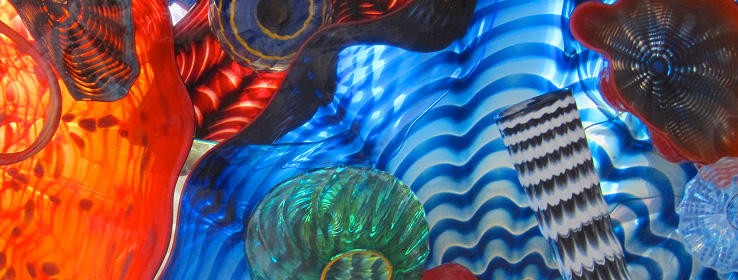Pioneering glass artist Dale Chihuly remains captivated by the unique colors and character of his fragile medium.
Dale Chihuly is credited with revolutionizing the American Studio Glass movement, transforming its premise from a single artist working alone to a team collaborating on massive, multipart installations. Yet Chihuly's work remains distinctively his own, a color-drenched celebration of organic forms.
STIR: What do you find so fascinating about glass?
DC: The transparency. Very few materials have that: plastic, ice and glass. Light coming through glass is so magical. The Chartres Cathedral in France has very famous windows, and [even from a great distance] you can see a 1-inch square of ruby red glass. It's that powerful.
STIR: You earned a degree in interior design, then switched to sculpture and glass-blowing. What inspired you to change course?
DC: I had been working with glass for a couple of years on my own. One day, I was working with melted stained glass and I blew on it and got a bubble, which was unusual. I got so excited about it that it signaled to me that's what I wanted to do.
STIR: What's your process when making color choices?
DC: I don't have a process. I just have a feeling: "Let's make this one blue." It just comes naturally. There's not a color I haven't worked with, and in every degree, from very transparent to opaque. The colors come in rods from Germany, and we have 1,000 colors altogether. We refer to them as numbers, like "15 blue."
STIR: How does your medium affect your use of color?
DC: If you blow a certain way, the glass goes more opaque or translucent. Blue and yellow don't always make green. Glass is less predictable because colors heat at different temperatures. Blues and blacks get hot faster than reds and yellows. If a hot color is next to a cool color, it will blow out softer. When you reheat it, it can get all bumpy. You just have to be careful and take it slowly.
STIR: You pioneered the use of collaborative teams to create large installations. What's the biggest color challenge of working collaboratively on big pieces?
DC: Different people on the teams do different things. I always have other people blow for me since I lost the sight of my left eye in a car accident. Sometimes I have just a colorist who works on an entire piece. Color goes on blown glass at many different times, and different people blow the glass differently.
STIR: How has your use of color evolved during your life as an artist?
DC: I happen to be doing a lot of work in black now, with the foundation all black and colors put on the surface. I'm not sure what started it. I hadn't done it before; it's a dramatic difference from my earlier work.
STIR: You developed a polymer material that you call Polyvitro. What is it, and what motivated you to create it?
DC: It's a type of plastic. Sometimes I want to do a piece that's too heavy for glass. Polyvitro weighs half as much as glass and it's more durable. You can't break it. If I'm doing a piece for outside, I can cast parts larger than I can with glass.
STIR: What colors do you surround yourself with at home?
DC: I like green a lot. My kitchen is all enameled custard yellow. My studio doesn't have much color, in the glass-blowing shop. Where I draw and paint, I have outdoor carpet – blue – because I use a lot of water when I draw, and it's messy.
STIR: What impact has technology had on glass-blowing?
DC: Very little. All the tools are the same as they were 2,000 years ago. The furnaces are almost the same, although the kneeling ovens are now computerized, so they're very accurate. It's one craft that's changed very little.







